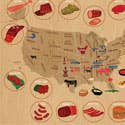
The South is the cradle of American barbecue. Though different sauces have developed over time (a vinegar-based one in eastern North Carolina, say, or a tomato-spiked version in the western part of the state), the pit-cooked pulled pork found in the States today dates back to the Colonial era. Before the Civil War, African-American slaves were the primary barbecue cooks, and in the next century, blacks brought the tradition across the country, west to Texas and then north to Kansas City, Memphis, Chicago, and other urban areas. Along the way, other animals entered the pit—chicken, beef, goat, even alligator—and cooks put their own spin on the tradition. In western Kentucky, where sheep-herding Welsh settled in the early 19th century, barbecued mutton became the gold standard. And while there are pockets of indigenous styles—smoked salmon in the Pacific Northwest; banana leaf-wrapped kalua (pit-cooked) pig in Hawaii; tri-tip in California; barbecue-filled tamales in the Mississippi Delta—in Texas, a barbecue tradition to rival the Southeast's emerged. Here, German and Czech meat markets and the local ranching culture converged to create a beef-centric menu of cuts like brisket, sausage, and dry-rubbed beef ribs. Memphis developed an especially polyglot barbecue culture, with local specialties like barbecue spaghetti (noodles tossed with bits of chopped pulled pork shoulder and sauce) and barbecued bologna adding to the standard offering of ribs and pulled pork. Kansas City's stockyards and meat-packing industry made it an incubator of different styles, and today it features the country's most diverse barbecue offerings, with beef brisket, ribs, burnt ends, pulled pork, chicken, ham, and turkey, all swathed in the city's signature thick, tomato-based sauce.
Keep Reading
Continue to Next Story










